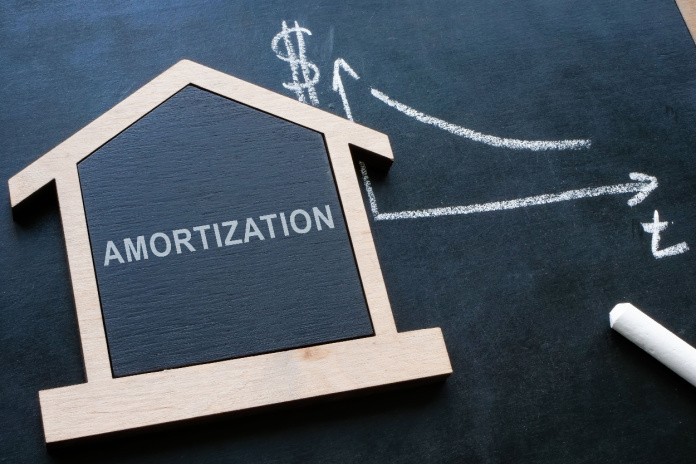Amortization is a term most people encounter when they first borrow money. It may be a car loan, a home loan, or a general personal loan. As will be discussed in greater detail in this post, amortization outlines the payback of principal along with the accompanying interest on the loan.
All of the payments are contained in a schedule which is provided the borrower. It is very important to understand all the details of this schedule. While it may appear to be simple, it is can also be complex. Understanding all the ramifications of the loan requires careful readying, asking questions, and having a good idea of the ramifications of each loan payment.
Amortization also is a tool utilized to assess the value of an intangible personal property. Again, that is a use that differs from the schedule discussed above and below.
Let’s now delve into what it means for the lender and borrower in a typical situation. It is important to realize exactly what the term “amortization” means.
PRINCIPAL VERSUS INTEREST
Paying back the principal owed on a loan is obvious. If a borrower needs $20,000 for an automobile loan, then the amortization schedule will detail how much of each payment is applied to the principal.
Of course, interest accrues on the loan from the date the money is given to the borrower. That interest is calculated based upon the interest rate of the loan. The higher the rate, the more interest is paid.
It is a given that the interest is front loaded. That means the early payments contain more interest than the later ones. The lender is collecting their interest up front. That means the amount of the principal owed does not decrease in an orderly fashion.
It may appear to the borrower that the amount of principal is decreasing at a slow rate. That is true. For a car loan, it can mean that early on in the loan more principal is owed that the vehicle is worth. A purchaser can find this out when the automobile is damaged in an accident.
Even if the damage is caused by a third party, the insurance payment may not cover the existing debt due to the application of payments to interest and not principal.
The practical effect is to make the owner having to keep their car until the principal amount owed equals or is less than the fair market value of the automobile.
The borrower can determine exactly where they stand by keeping the amortization schedule in front of them. We will delve into that schedule in the next section.
SCHEDULE
Anyone taking out a loan needs to read the amortization schedule and keep a copy. It is as simple as that. They also need to ask questions before agreeing to the loan. Although there is no negotiation about the schedule, a borrower needs to understand what they are agreeing to before signing the loan papers.
The schedule details each payment, the due date, and how much goes to principal with the remainder being interest. A quick look will show that each succeeding payment will apply more to principal and less to interest. Of course, that amount will only move slowly in that direction.
As pointed out below in payments, extra payments change the payoff but do not alter how the payments are applied. Each future payment remains the same.
PAYMENTS
Anyone wishing to see how much payments would be on a loan can utilize an amortization calculator found online. The prospective borrower needs to know the amount of the loan, interest rate, and the number of months or years to pay back the loan. The calculator will then provide the monthly or yearly payment, and it will show how much goes of principal and interest in each payment.
There is one more very important concept involving payments. If an individual decides to make one or more payments in an amount greater than listed in the amortization table, then that affects the principal owed. It does not change future payments. They remain the same.
Take an example. The monthly payment is $614.22. The borrower rounds up and pays $615.00. The extra 78 cents goes towards reduction of the principal owed. This is a simple example.
A more realistic scenario would be to pay $650 every month. That extra $35.78 would go towards principal reduction. It would not change the monthly payment due. It is possible, but not guaranteed, that the lender would notice the extra money and offer the borrower the opportunity to skip a payment.
That decision would be up to the borrower. If the purpose is paying off the loan earlier or reducing the amount of interest paid, then the individual would reject the offer and keep paying. There would be no obligation to pay extra each month. It would still remain an option.
The borrower would only be obligated to pay the $614.22. Extra payments is always an option but never an obligation.
INTANGIBLE ASSET
Intangible is the opposite of tangible. Something tangible can be seen and felt. An example would be furniture. Intangible examples include goodwill or a license. Both have value to a business. Amortization of these intangibles is an accounting principle used to put the value over a period of years for tax purposes.
The simple answer is that amortization spreads costs over a period of years. That is due to the fact that the intangible asset has value for more than one year.
Amortization is an important factor in any loan. As discussed above, it is critical for any borrower to fully understand the concept. It plays out in the payment of the loan. It also is impacted by any prepayments, whether in lump sum or on a regular basis.
The simple rule is to understand amortization before executing those loan payments. It will save headaches in the long run.
